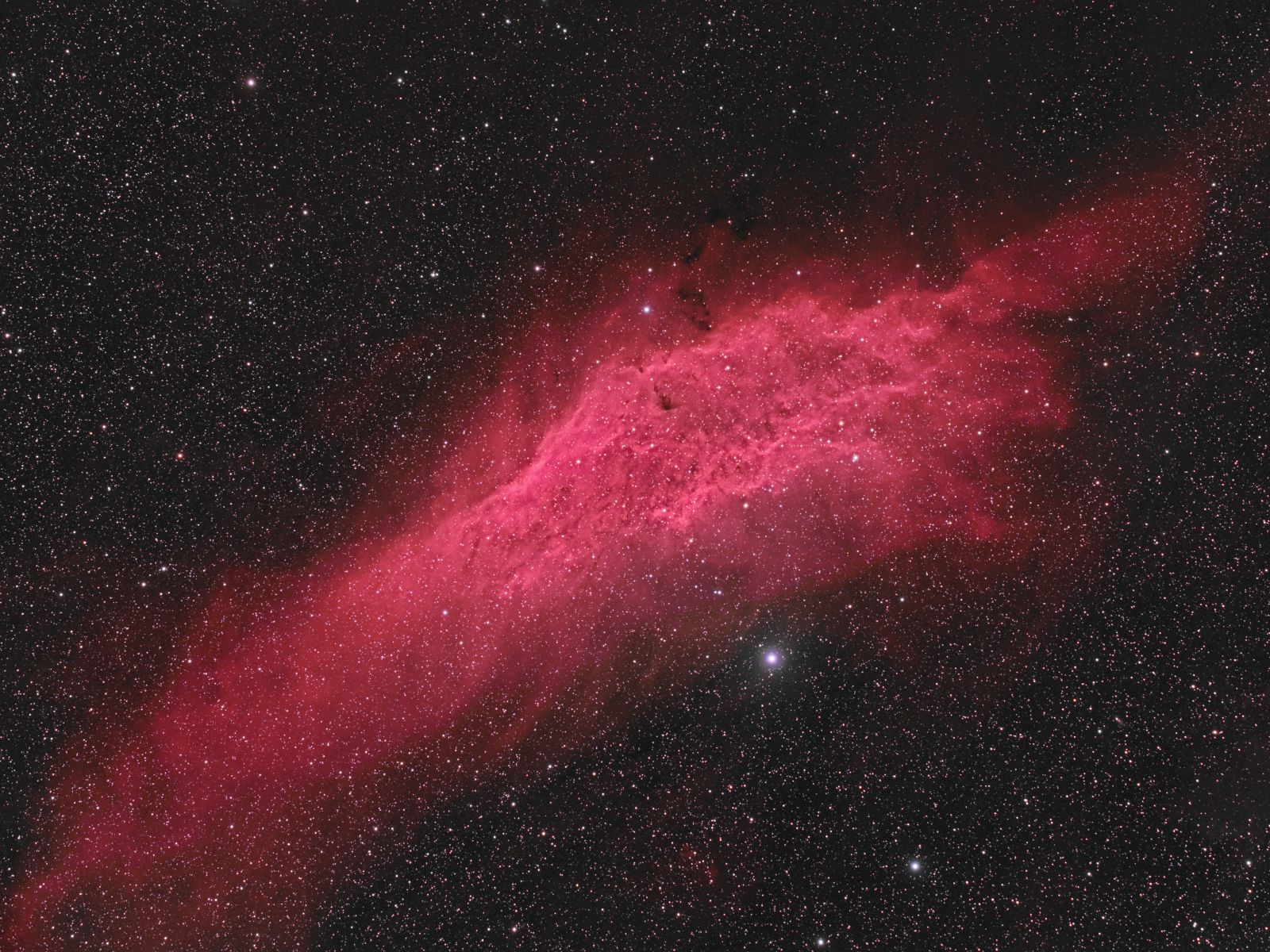The California Nebula
 Click image for full size version
Click image for full size version
February 3, 2020
The California Nebula (NGC 1499) is so named because its shape is reminiscent of the U.S. state of the same name. It is very difficult to see visually (I have tried and failed many times) but looks gorgeous in pictures. The California Nebula lies about 1,000 light years from Earth in the constellation Perseus. The nebula is made mainly of hydrogen, which is glowing due to energy released from the brightest star in the image, a blue giant star called Menkib, or Xi Perseus. Menkib is 13,500 times as bright as the Sun in visible light and has a temperature around 37,000C, making it one of the intrinsically brightest and also the hottest star visible to the naked eye (note – if you include UV light its luminosity is 330,000 times the Sun’s). Menkib, like all massive stars, is living fast and will die young — maybe exploding in the next million years or so. In the upper left of this image, you can also find at least 6 small galaxies, some of which show some structure. Look for fuzzy “stars” or little needle-like objects.
Tekkies:
Takahashi FSQ-106 ED IV @ f/3.6, QHY367C one-shot colour camera, and Optolong L-eNhance narrowband filter, Paramount MX, unguided. Acquisition, and focusing with TheSkyX. Focus with Optec DirectSync focus motor and controller. Automation with CCDCommander. Equipment control with PrimaLuce Labs Eagle 3 Pro computer. All pre-processing and processing in PixInsight. Acquired from my SkyShed in Guelph. Variable moon, average to above average transparency and fair to average seeing. Data acquired October 28, 2019 – January 16, 2020. Additional data acquired in 2016; see details below.
74x10m with Optolong L-eNhance filter (Total = 12hr20m)
Additional data from 2016 capture using different equipment (Total 4hr30m)
Image scale 2.6 arcsec per pixel
Data Reduction and Cleanup
Preprocessing: The WeightedBatchPreProcessing script was used to perform calibration, debayering, and registration of all frames. ImageIntegration followed by DrizzleIntegration with the CFA Drizzle option was used to make the master, which was then cropped. For DrizzleIntegration, a scale of 2 and drop-shrink of 0.9 was used.
Channel Registration: To improve channel registration, the RGB colour channels were extracted and aligned with StarAlignment, using Thin Plate Splines with Distortion Correction and the green channel as the reference frame. The registered colour channels were recombined with ChannelCombination.
Gradient Removal: DBE was applied using Subtraction to remove the minimal gradient that remained after integration.
Lightness Extraction: RGBWorkingSpace was applied to normalize the channels, and the Lightness was extracted for separate processing as described below.
Colour
Colour Balancing: The colour image was colour balanced with ColorCalibration.
Linear Noise Reduction: MultiscaleLinearTransform was used to reduce noise in the background areas, using an internal mask to protect bright structures. Layer settings for threshold and strength: Layer 1: 5.0 0.85, 2 iterations; Layer 2: 3.5, 0.75, 2 iterations; Layer 3: 3.0, 0.5, 1 iteration; Layer 4: 1.0, 0.25, 1 iteration.
Stretching: HistogramTransformation was applied to make a pleasing, bright image, with background set to an intensity of approximately 0.10.
Lightness
Deconvolution: StarMask was applied with default settings to produce a Local Deringing Support Image. A clone of the image was stretched to use as a deconvolution mask. Deconvolution was applied (200 iterations, regularized Richardson-Lucy, external PSF made using PSFImage script with about 30 stars).
Linear Noise Reduction: MultiscaleLinearTransform was used to reduce noise in the background areas, using an internal mask to protect bright structures. Layer settings for threshold and strength: Layer 1: 3.0 0.85, 1 iterations; Layer 2: 2.5, 0.75, 1 iterations; Layer 3: 1.0, 0.5, 1 iteration; Layer 4: 0.5, 0.25, 1 iteration.
Stretching: HistogramTransformation was applied to make a pleasing, bright image, with background set to an intensity of approximately 0.10.
Recombining Lightness and Colour Images
LRGB Combination: The lightness image was applied to the RGB image using LRGBCombination with default settings.
Additional Processing
Nonlinear Noise Reduction: TGVDenoise was used in L*a*b* mode to reduce noise with a mask used to target the background areas and protect the stars (max. 1000 iterations and convergence selected for both lightness and chrominance).
Contrast Enhancement: LocalHistogramEqualization was applied twice (scale of 50 with strength 1.0; then scale of 150 with strength 0.5) using a mask to protect stars and low-signal regions of the image.
Final Steps: Background, nebula and star brightness, contrast, colour saturation were adjusted in several iterations using CurvesTransformation with masks as required. Hue was adjusted using the following expression in PixelMath without rescaling, with a star mask in place to protect the stars:
R: iif($T[0]>0.20, 1.02*$T[0], $T[0])
G: iif($T[0]>0.22, 0.93*$T[1], $T[1])
B: iif($T[0]>0.22, 1.07*$T[2], $T[2])
The high-resolution core of a previous 2016 image was blended in with PixelMath followed by curves using a mask to increase definition in the core. The DarkStructureEnhance script was applied with a strength of 0.2. The image was rescaled to its original scale of 2.6″/pixel. ICCProfileTransformation (sRGB IEC61966-2.1; Relative Colorimetric with black point compensation) was applied prior to saving as a jpg.






Besides the Obvious that this is an AMAZING IMAGE… I can actually UNDERSTAND and FOLLOW everything you stated above (well except the drizzle and spline stuff)~ BECAUSE of your amazing teachings.
IF anyone has any doubt about your instruction please send them my way. Personalized lessons have made me a much stronger astrophotographer. THANK YOU